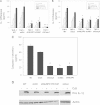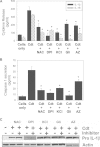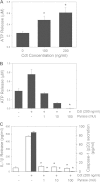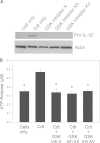Aggregatibacter actinomycetemcomitans cytolethal distending toxin activates the NLRP3 inflammasome in human macrophages, leading to the release of proinflammatory cytokines
- PMID: 25644004
- PMCID: PMC4363449
- DOI: 10.1128/IAI.03132-14
Aggregatibacter actinomycetemcomitans cytolethal distending toxin activates the NLRP3 inflammasome in human macrophages, leading to the release of proinflammatory cytokines
Abstract
The cytolethal distending toxin (Cdt) is produced from a number of bacteria capable of causing infection and inflammatory disease. Our previous studies with Actinobacillus actinomycetemcomitans Cdt demonstrate not only that the active toxin subunit functions as a phosphatidylinositol-3,4,5-triphosphate (PIP3) phosphatase but also that macrophages exposed to the toxin were stimulated to produce proinflammatory cytokines. We now demonstrate that the Cdt-induced proinflammatory response involves the activation of the NLRP3 inflammasome. Specific inhibitors and short hairpin RNA (shRNA) were employed to demonstrate requirements for NLRP3 and ASC as well as caspase-1. Furthermore, Cdt-mediated inflammasome activation is dependent upon upstream signals, including reactive oxygen species (ROS) generation and Cdt-induced increases in extracellular ATP levels. Increases in extracellular ATP levels contribute to the activation of the P2X7 purinergic receptor, leading to K+ efflux. The relationship between the abilities of the active toxin subunit CdtB to function as a lipid phosphatase, activate the NLRP3 inflammasome, and induce a proinflammatory cytokine response is discussed. These studies provide new insight into the virulence potential of Cdt in mediating the pathogenesis of disease caused by Cdt-producing organisms such as Aggregatibacter actinomycetemcomitans.
Copyright © 2015, American Society for Microbiology. All Rights Reserved.
Figures






Similar articles
-
Cytolethal distending toxin-induced release of interleukin-1β by human macrophages is dependent upon activation of glycogen synthase kinase 3β, spleen tyrosine kinase (Syk) and the noncanonical inflammasome.Cell Microbiol. 2020 Jul;22(7):e13194. doi: 10.1111/cmi.13194. Epub 2020 Mar 4. Cell Microbiol. 2020. PMID: 32068949 Free PMC article.
-
Shiga Toxins Activate the NLRP3 Inflammasome Pathway To Promote Both Production of the Proinflammatory Cytokine Interleukin-1β and Apoptotic Cell Death.Infect Immun. 2015 Oct 26;84(1):172-86. doi: 10.1128/IAI.01095-15. Print 2016 Jan. Infect Immun. 2015. PMID: 26502906 Free PMC article.
-
Serum amyloid A activates the NLRP3 inflammasome via P2X7 receptor and a cathepsin B-sensitive pathway.J Immunol. 2011 Jun 1;186(11):6119-28. doi: 10.4049/jimmunol.1002843. Epub 2011 Apr 20. J Immunol. 2011. PMID: 21508263
-
Silica-induced inflammasome activation in macrophages: role of ATP and P2X7 receptor.Immunobiology. 2015 Sep;220(9):1101-6. doi: 10.1016/j.imbio.2015.05.004. Epub 2015 May 18. Immunobiology. 2015. PMID: 26024943 Review.
-
The inflammasome: an integrated view.Immunol Rev. 2011 Sep;243(1):136-51. doi: 10.1111/j.1600-065X.2011.01046.x. Immunol Rev. 2011. PMID: 21884173 Review.
Cited by
-
Nrf2 in the Field of Dentistry with Special Attention to NLRP3.Antioxidants (Basel). 2022 Jan 12;11(1):149. doi: 10.3390/antiox11010149. Antioxidants (Basel). 2022. PMID: 35052653 Free PMC article. Review.
-
Recent Aspects of Periodontitis and Alzheimer's Disease-A Narrative Review.Int J Mol Sci. 2024 Feb 23;25(5):2612. doi: 10.3390/ijms25052612. Int J Mol Sci. 2024. PMID: 38473858 Free PMC article. Review.
-
Cytolethal distending toxin-induced release of interleukin-1β by human macrophages is dependent upon activation of glycogen synthase kinase 3β, spleen tyrosine kinase (Syk) and the noncanonical inflammasome.Cell Microbiol. 2020 Jul;22(7):e13194. doi: 10.1111/cmi.13194. Epub 2020 Mar 4. Cell Microbiol. 2020. PMID: 32068949 Free PMC article.
-
Periodontitis Exacerbates and Promotes the Progression of Chronic Kidney Disease Through Oral Flora, Cytokines, and Oxidative Stress.Front Microbiol. 2021 Jun 11;12:656372. doi: 10.3389/fmicb.2021.656372. eCollection 2021. Front Microbiol. 2021. PMID: 34211440 Free PMC article. Review.
-
The Cytolethal Distending Toxin Contributes to Microbial Virulence and Disease Pathogenesis by Acting As a Tri-Perditious Toxin.Front Cell Infect Microbiol. 2016 Dec 5;6:168. doi: 10.3389/fcimb.2016.00168. eCollection 2016. Front Cell Infect Microbiol. 2016. PMID: 27995094 Free PMC article. Review.
References
-
- Okuda J, Kurazono H, Takeda Y. 1995. Distribution of the cytolethal distending toxin A gene (cdtA) among species of Shigella and Vibrio, and cloning and sequencing of the cdt gene from Shigella dysenteriae. Microb Pathog 18:167–172. - PubMed
Publication types
MeSH terms
Substances
Grants and funding
LinkOut - more resources
Full Text Sources
Miscellaneous

